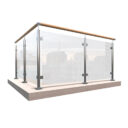What you should know about glass railings?
This article explains important nuances for various glass railings that arise from technical requirements and from our experience. For example, it is often asked how thick the glass panes of a glass railing must be, or what type of railing it would be reasonable to build. There is no one answer, and everything depends on the circumstances of the design, but there are some rules that may be pointed out.
Line load requirements for railings
In the case of railings, it should be known that there are general requirements for the use of railings in Europe. The line load is expressed in kN/m, which shows the number of kN horizontal loads that affect one meter of the upper edge of the railing.
For example, if we push the upper edge of the 3-metre balcony railing evenly outside with a force of 3 kN (or 300 kg), the railing is exposed to an line load of 1 kN/m. Line loads are classified as follows:
- 0.5 kN/m – railings in living spaces
- 1 kN/m – railings in public spaces
- 3 kN/m – railings in spaces meant for public gatherings (e.g. stadium stands)
Types of glass railings
From the point of view of their structure, glass railings can be categorized as follows:
- Glass railings
- Fixed with a bottom profile
- Point-fixed
- Glass railings with posts
In the case of a glass railing, the glass itself receives the full load and must therefore be thicker than in the case of a railing with posts.
The general rule is that in the case of a glass railing with a bottom profile, a toughened-laminated glass with a thickness of 6+6 mm is used in living spaces (0.5 kN/m), in public spaces (1 kN/m) 6 +6 mm or 8 +8 mm and in stadium stands (3 kN/m) 10 +10 mm or 12 +12 mm.
In some cases, monolithic toughened glasses with a thickness of 10 mm or 12 mm are used in glass railings, but this should not be done in the event of a risk of falling. For more detailed information regarding suitable glass thickness for glass railings with a bottom profile, use our calculator.
It is more difficult to recommend a suitable glass thickness for a point-fixed glass railing, since besides operating load there are other factors, such as horizontal and vertical spacing between points, that need to be kept in mind.
In addition, in the case of point fixing, account must be taken of the fact that the fixing apertures in the glass make the glass weaker, as there are stress concentrators around the apertures.
In general, however, it can be said that in living spaces (0.5 kN/m) toughened-laminated glass of a thickness of 8 +8 mm and in public spaces (1 kN/m) of 10 +10 mm could be used. In rooms intended for public gathering (3 kN/m) it is not possible to use a point fixed glass the glass pane of which would be of reasonable thickness.
Suitable point fixings for full glass railings
In addition to the thickness of the glass, it must be borne in mind that the diameter of point fixings suitable for a glass railing is between 45 mm and 60 mm. When smaller point fixings are used, too great point stress will be generated around the apertures, which might break the glass.
The horizontal distance between each pair of point fixings should be a maximum of 0.5 metres, i.e. a minimum of 4 point fixings per 1 metre must be used. The vertical distance between the upper and lower point fixings should be a minimum of 120 mm from centre to centre, but the larger the vertical distance, the better the railing can withstand the load. The distance of the point fixing from the edge of the glass must be at least 2 times the thickness of the glass and in the corner of the glass 6 times the thickness of the glass.
Load for a pillared glass railing
In the case of a glass railing with posts, the posts and the handrail attached to them will receive the load imposed on the railing. Ø42.4 x 2 mm stainless steel round tube and 40 x 40 x 2 mm rectangular tube are widely used as a material for posts and handrails, which make it possible to make a glass railing with a load resistance of up to 1 kN/m, provided the distance between the posts is not over 1 m.
Between the posts, the glass is usually fixed with glass clamps, so there is no need to make fixing apertures in the glass. If there is a risk of falling, it is important to use laminated glass with a thickness of 4+4 mm, 5+5 mm or 6+6 mm depending on the requirements of the design.
Glass subsidence risk
When fixing with glass clamps, it should be taken into account that the glass may, under certain circumstances, start sliding off from between the clamps over time. This phenomenon may be caused by, for example, vibration of the glass caused by the wind, fluctuation of the cold-warm temperature or a thin layer of oil remaining on the glass surface after treatment.
To prevent the risk of glass collapsing, we recommend using safety plates for glass clamps that can be ordered as optional accessories for some clamps. In case of some clamps, safety plates are already included in the set.
Alternatively, safety pins that come with the glass clamps can be used, although they require that there are pre-milled apertures in the glass in the right places.
Glass railing requirements can differ
It is important to note that there are often different national requirements for glass railings in different countries. For example, in some countries it is required that glass deflection under load should not exceed a certain value.
In this article the specific requirements of different countries are not taken into account, but it contains recommendations in accordance with the standard EN1991-1-1:20 00 Eurocode 1: “Actions on structures” and from our experience.
Get in touch with us
If you have questions about our products, delivery or special solutions, please feel free to contact us. Hardi will respond to your letter. It is best to use the contact form below.






